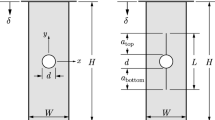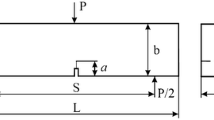Abstract
Laboratory tests show that for some graphites the calculated stress at failure exceeds the tensile strength in uniform tension by an amount which depends on the test considered and increases with the severity of the stress gradient. Fracture mechanics has been applied to bend, internal pressure and diametral compression tests to investigate whether it can provide a consistent failure criterion for graphite in situations where stress gradients are important. A finite element method of analysis has been used to compute the stress distributions in specimens containing cracks of various lengths, from which energy release rates and stress intensity factors have been derived. The results indicate that there is not constant effective inherent crack size which can be employed with a constant critical stress intensity factor K IC to predict the failure conditions in the three tests considered. However, assuming a constant K IC, a relationship has been found between the effective inherent crack size responsible for failure and the maximum stress gradient in a specimen, which may be of value in developing a fracture criterion for practical purposes.
Résumé
On montre par des essais de laboratoire que, dans le cas de certains graphites, la contrainte calculée à la rupture dépasse la tension de rupture en traction uniforme d'une quantité qui dépend de l'essai et qui s'accroit avec la sévérité du gradient de contrainte. La mécanique de rupture a été appliquée à des essais de flexion, de pression interne et de compression diamétrale, afin de se rendre compte si elle pourrait fournir un critère de rupture significatif pour le graphite pour les cas où les gradients de contraintes sont importants. Une méthode d'analyse par éléments finis a été appliquée au calcul des distributions des contraintes dans des éprouvettes comportant des fissures de différentes longueurs. On en a tiré les taux de relaxation de l'énergie de déformation et les facteurs d'intensité des contraintes. Les résultats montrent qu'il n'y a pas de dimensions effectivement constantes de fissure susceptible d'être associée à un facteur d'intensité des contraintes constant K IC pour prédire la rupture dans les trois essais envisagés. Toutefois, en supposant une valeur constante pour K IC, on a pu établir une relation entre la dimension effective de la fissure provoquant la rupture et le gradient maximum de contrainte dans l'éprouvette. Cette constatation peut être intéressante pour développer un critère de rupture correspondant à des problèmes pratiques.
Similar content being viewed by others
References
J. E. Brocklehurst and M. I. Darby, Materials Science Engineering, 16 (1974) 91–106.
J. E. Brocklehurst and R. G. Brown, Fracture, notch sensitivity and work of fracture studies on isotropic graphite, UKAEA TRG Rept. 2513(S) (1974).
P. Marshall and E. K. Priddle, Carbon, 11 (1973) 541.
P. Marshall and E. K. Priddle, Carbon, 11 (1973) 627.
J. E. Brocklehurst and K. E. Gilchrist, The fracture of graphite ring specimens by diametral compression and internal pressure, UKAEA TRG Rept. 1774(C) (1968).
J. R. Dixon and J. S. Strannigan, Journal of Strain Analysis, 7 (1972) 125–131.
P. C. Paris and G. C. Sih, Stress analysis of cracks, Symposium on fracture toughness testing and its applications, 1965 (Philadelphia, Pa) A.S.T.M. Special Technical Publication 381, 30–83.
W. D. Collier, J. P. Ellington and P. M. Rees, TRESS, A finite-element code for stress analysis problems, UKAEA TRG Rept. 1813(R).
O. C. Zienkiewicz, The finite-element method in structural and continuum mechanics, McGraw-Hill Book Co. Inc., New York and London (1967).
J. Corum, Journal of Nuclear Materials, 22 (1967) 41–54.
C. Fairhurst and M. P. Hardy, Fracture in rocks and engineering implications, Proceedings of 3rd International Congress on Fracture, München, W. Germany.
Author information
Authors and Affiliations
Rights and permissions
About this article
Cite this article
Darby, M.I. A fracture mechanics approach to the failure of graphite in laboratory tests. Int J Fract 12, 745–757 (1976). https://doi.org/10.1007/BF00037920
Received:
Issue Date:
DOI: https://doi.org/10.1007/BF00037920




